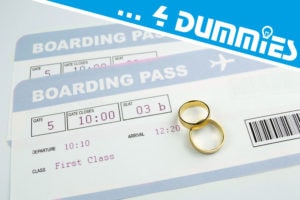Everybody who has ever traveled has come across those terms, but have you ever wondered what they all mean? This article of the series Travel Technology for Dummies will shed some light on what it means if somebody has a booking, is waitlisted or actually has a ticket (or an interline ticket).
1. Booking
A booking is nothing else than a reservation and is often used similar to a PNR. According to Forrester Research, travel bookings are the single largest component of e-commerce. A booking is often defined as one or more PNRs which belong to the same itinerary. So one could say a booking is a booked itinerary, as PNRs exist for the different entries of an itinerary. Booking or a “booked PNR” means that inventory is assigned to this PNR at a certain price. However, with a booked PNR in the airline world, such inventory is usually only temporarily assigned and if such PNR is not “ticketed”, then after a certain period the airlines “void” such PNR. Meaning: the inventory becomes available to others again, whoever booked it has no right to such inventory any longer and needs to book it again – most likely at a different price. In summary, a booked PNR secures a seat on the booked segments for a certain time window (usually 24 hours) – subject to overbooking regulations. Many companies employ automated processes to look at all booked or ticketed PNRs to check if there are cheaper options available (like if a cheaper booking class becomes available). Should they be successful in finding a better alternative, depending on the status of such PNR, they can void or rebook such PNR in the cheaper booking class (taking potential rebooking fees, ancillary services, assigned, etc. into consideration).
2. Waitlist
An additional instrument used in business travel is waitlisting a flight. This often means you book one class (e.g. economy) and waitlist for another class (e.g. business) in a case where one class (in this case business class) is sold out. Should, in this example, business class become available, that person will be booked in business class and the coach class seat will become available (e.g. for somebody who was waitlisted for coach in case the flight was sold out).
3. Ticketing
What is the difference between booking and ticketing? A ticketed PNR means that the segments in that PNR were actually paid for and thus such specific inventory will not be made available to others unless it is changed or cancelled. Once ticketed, a flight is usually paid for or the form of payment will be debited soon. In business travel, especially when it comes to trips departing soon, a PNR is often booked even without a price. This happens when the company wants to make sure that they may elect to use the booked inventory regardless of the prize to ensure their employee can get from A to B. As in many cases no payment is required at the time of booking, they may elect to book such inventory, continue their search and then void or ticket it. One should watch out though: Certain fares may be auto-ticketed and many low-cost carriers have instant ticketing, which means that at the time of booking, the flight is also ticketed – which requires a form of payment. In 1994, electronic ticketing started in the airline industry. E-ticketing has largely replaced the older multi-layered paper ticketing systems, and since mid-2008, it is mandatory for IATA members.
4. Codeshare
Airline codeshare is an aviation business arrangement where airlines share the same flight – meaning that each airline publishes and markets the flight under its own airline designator and flight number. A flight I sometimes take on my trips to Germany is Lufthansa’s LH 5895 from Miami to Zurich (Switzerland). The actual carrier (commonly called the operating carrier or, more precisely and in line with definitions in the IATA Standard Schedules Information Manual, “administrating carrier”) is Swiss; its airline designator is LX and its flight number is 65 – so LH 5895 and LX 65 are the same flight. This can sometimes be confusing when codeshare partners don’t share the same check-in booth. With Lufthansa and Swiss this is not the case mostly, but I once ended up waiting at the Lufthansa line, just to learn that I have to go to a different terminal and check in with United (almost missing my flight). The Department of Transportation (DoT) demands travel booking sites to always display the operating carrier so that travelers have transparency of whom they are flying with (airline safety records might also differ from codeshare to operating carrier and thus influence buying decisions). The DoT usually fines sites which do not comply with such regulations.
5. Interline
Interline (also known as interline ticketing and interline booking) is a commercial agreement between individual airlines to handle passengers traveling on itineraries that require multiple flights on multiple airlines in order to allow them to change airlines without having to gather their bags or check in again. Interlining agreements differ from code-share agreements where a flight is numbered with the airline’s code although it is operated by another airline. If you fly for instance from Dubai to New York on Emirates and then carry on to Miami on American, this requires an interline agreement between Emirates and American for you to not have to check in again (you may still have to gather your bags, bring them through customs and then re-check them though). In case that no interline ticketing agreement exists, two separate tickets will need to be issued and passengers will definitely have to retrieve their bags and carry them to the connecting airline for check-in. Such Itineraries are riskier for travelers since the second carrier may be unaware of delays or issues with the incoming flight and it is more likely for luggage to be lost. Interline agreements often exist for competing carriers when one carrier flies into the other one’s market – such as Emirates flying into American’s home market. Ticketing of such itineraries can use a single electronic ticket (e-ticket) and is also called interline electronic ticketing (IET).
Codeshare relationships can affect whether an interline ticket (or e-ticket) can be issued since both the codeshare marketing carrier and codeshare operating carrier must have interline agreements with all other carriers in the itinerary in order to allow a single ticket to be issued. Alliance airlines almost always have interline agreements with each other. But competing carriers can also benefit from interline agreements. When a ticket for an interline itinerary is issued, one of the airlines in that itinerary will be selected as the issuing airline by the ticketing agent. Only the issuing carrier is responsible for paying commission to the agency. The amount of commission is based on the entire air fare, although the percentage amount varies from the amount paid if only a single airline was involved.
Blog Series: Travel Technology for Dummies
- What Is Full Content?
- What Is a Booking Reference or PNR?
- What Is Overbooking?
- What Is a Passenger Service System (PSS)?
- What Are Booking, Waitlists, Tickets, Codeshare & Interlining?
- What Are Active and Passive Segments?
- What Are Incentives, Commissions & Overrides?
- What Is a ‘Married Segment’?
- Blockchain in Travel: All You Need to Know – for Now
- What Is the Difference Between Fares, Rates and Tariffs?
- What Is NDC?
- What Is Continuous Pricing?
- What Is Direct vs. Indirect Distribution?
Picture credit: Shutterstock





This Post Has 5 Comments
Good question: To be honest, I don’t know how the interline agreements are constructed and who pays what kind of fees. I assume it may be even different from airline to airline depending on the interline agreements. Sorry – if anybody knows better, feel free to post.
Dear Michael,
Thank you for the informative articles. About the interline commissions you mentioned that “Only the issuing carrier is responsible for paying commission to the agency”.
As for GDS fees, each airline pays for its segment fees, right? Shall we consider the flight code designator, or operating carrier(for codeshare flights) for the responsible party for the fee?
[…] shifts to the airline – even during the trip. It becomes especially interesting when interline partners are involved. Even though an Offer Responsibility Airline (ORA) has been defined in […]
Dear Nida,
I will keep this in mind!
I hope you are also aware of our developer’s helppage that includes PNR creation and ticketing messages, which may help understanding the process (at least when using our Multi-GDS product XX1 https://www.pass-consulting.com/en/industries/travel/travel-xml-api/):
– XX1-help Startpage: https://xx1.pass-consulting.com/
– all messages: https://xx1.pass-consulting.com/documentation/xx1-travel-sdk/v1-7-3/messages/
– PNR Create messages/schemas/definitions: https://xx1.pass-consulting.com/documentation/xx1-travel-sdk/v1-7-3/messages/pnrcreaterq/
– Ticket Create messages/schemas/definitions: https://xx1.pass-consulting.com/documentation/xx1-travel-sdk/v1-7-3/messages/ticketissuerq/
I hope this helps as well.
Thank you,
Michael
Dear Michael
Your blog is really helpful to clarify the confusing terms in the travel industry. It will be so great if you could also consider writing a dummy article about the process of creating PNR/ ticketing, time limit and AP rules. This is another area where it is hard to find clear information on the web.
Thank you,